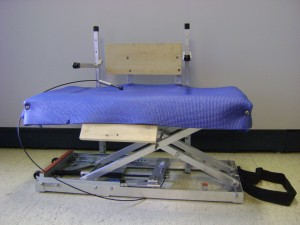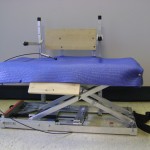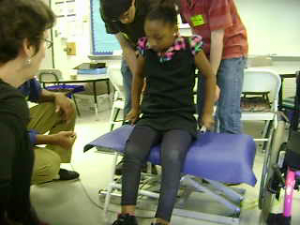Designers: Ankit Gupta, Jillian Haac, Nabil Khan, and Vishal Rao
Client Coordinator: Charlotte Hughes, PT
INTRODUCTION
Our client, “Zoe,” is an 8-year old girl who sustained a spinal cord injury two years ago that left her with paralyzed lower extremities and mild respiratory difficulty. Using her arms, Zoe can propel a manual wheelchair and move independently on the floor. However, she cannot independently transfer between her wheelchair and the floor. As she continues to grow, it now takes two assistants to safely transfer her to the floor and vice-versa. Unfortunately, Zoe does not always have access to two assistants at the home or classroom setting. This limits her ability to participate in classroom floor activities, and makes it difficult for her to get in and out of her wheelchair at home. There are no current products on the market that can assist Zoe with getting to and from the floor. While there are devices that are utilized to move loads vertically, most are designed to lift cars or industrial crates and exceed the force needed to lift a person; this renders current products both cost prohibitive and unsafe for human use.
The goal of this project was to develop a device that allows the client to move between her wheelchair and the floor with the assistance of only one other person. Using her arms, she can perform a depression lift to lift her body weight up 5 inches. Therefore, the device platform needs to get within 5 inches of the target height of the floor or wheelchair seat. The device must be lightweight, compact and portable so that Zoe’s caretakers are able to easily transport it between school and home.
SUMMARY OF IMPACT

Figure 1: The Lift Me Up device, with the platform about half way between its highest and lowest positions.
“The ‘Lift Me Up’ project will allow a young girl with paraplegia to get out of her chair and sit on the carpet with her peers during several activities during her school day. She feels more a part of the group when she is on the floor with them rather than sitting above them in her chair, where she feels more separate. She has adequate sitting balance so she feels safe on the floor but she is only able to get out when there are 2 teachers in the classroom to safely lift her back into her chair. The student may also use the lift at home so that she can join her younger sibling for play on the floor and then move safely back to her chair with assistance from only one adult.” -Quote from Ms. Charlotte Hughes, School Physical Therapist
TECHNICAL DESCRIPTION
The device has a platform that moves up and down to allow Zoe to transfer between her wheelchair and the floor. The operation is similar to that of an adjustable office chair, in which the users pulls up on a lever to unlock a gas spring; de-weighting allows the spring to push the chair up, while the weight of the user on the chair will push it back down. In our device, the client pushes a button to unlock the gas spring, allowing the lift to move up when she de-weights herself, or move down when her weight is on the platform.
Our device is based on a scissor lift design, which is often used in an industrial setting in order to lift heavy objects. It consists of two sets of diagonal arms attached to each of the corners of the top and bottom platform. The scissor lift mechanism is efficient because it provides a large vertical height displacement for a small mechanical input force. We constructed the lift out of 1” square aluminum tubing with a wall thickness of 1/8”. This provides the device with adequate strength, but is also lightweight. On one side of the bottom and top platform, the crossing, diagonal arms are mounted to heavy-duty drawer slides. This allows these ends of the arms to move horizontally along the top and bottom frames, as the platform is raised and lowered.
We used a lockable gas spring to apply the force needed to control the raising and lowering of the platform. The gas spring sits inside the frame of our bottom platform and it produces the force needed to push the arms of the scissor lift up. The locking action is controlled by a button that attaches to the gas spring via a cable.
Because Zoe does not have control over her legs, we developed a system in which she pushes on armrests to de-weight herself. The armrests slide up and down a pair of vertical stability bars. These stability bars attach to the bottom platform and they are 30” tall. They are located to the left and right of where Zoe sits on the platform. When Zoe tilts the armrests at an angle, she can slide the armrests up and down along the stability bars to reach a comfortable position, no matter what is the current height of the platform. When she applies a downward force on the armrests, they do not slide because of friction, and they can support her entire weight. When she de-weights herself, the gas spring can extend to raise the platform.
Aluminum angle-strips were used to create a rectangular frame for the top and bottom platform. A steel wire frame manufactured for cabinet shelving was used to create the surface for the top platform. A yoga mat was attached to this wire frame as a seat cushion to ensure comfort. The surface of the yoga mat allows Zoe to slide on it while she is transferring onto the platform, but it also has some friction to prevent unexpected slipping.
There is a short ramp, about 5 inches long, extending from the front of the platform, which will direct Zoe’s legs away from the scissor lift mechanism. This will avoid any possible injuries that could occur if her legs went under the platform while it is lowering. This same ramp will assist Zoe in moving onto the platform from the floor when the device is in its lowered position. There is also a backrest made of a lightweight wood attached to the top platform between where the armrests are positioned. This ensures that Zoe will not fall back off of the platform while it is moving or during transfer.
To make the device portable, we attached wheels to the short side of the bottom platform. A strap is attached to the opposite side so the parent or teacher can pull the device while it is rolling on its wheels. The device weighs 30 pounds, so an adult can lift it into a car or over steps.
The final cost of this device was $545.



University Operator: (919) 962-2211 | © 2024 The University of North Carolina at Chapel Hill |